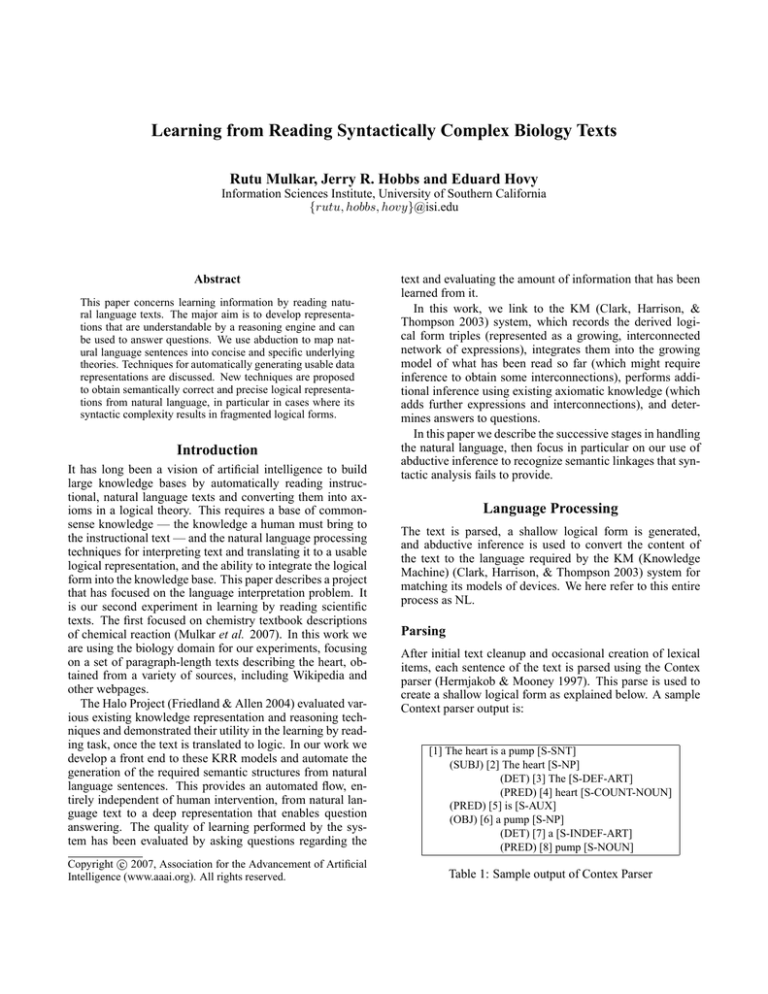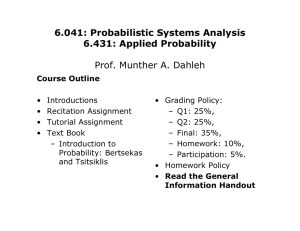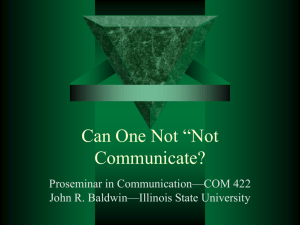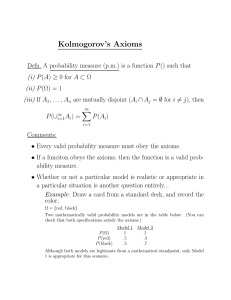
Learning from Reading Syntactically Complex Biology Texts
Rutu Mulkar, Jerry R. Hobbs and Eduard Hovy
Information Sciences Institute, University of Southern California
{rutu, hobbs, hovy}@isi.edu
Abstract
This paper concerns learning information by reading natural language texts. The major aim is to develop representations that are understandable by a reasoning engine and can
be used to answer questions. We use abduction to map natural language sentences into concise and specific underlying
theories. Techniques for automatically generating usable data
representations are discussed. New techniques are proposed
to obtain semantically correct and precise logical representations from natural language, in particular in cases where its
syntactic complexity results in fragmented logical forms.
Introduction
It has long been a vision of artificial intelligence to build
large knowledge bases by automatically reading instructional, natural language texts and converting them into axioms in a logical theory. This requires a base of commonsense knowledge — the knowledge a human must bring to
the instructional text — and the natural language processing
techniques for interpreting text and translating it to a usable
logical representation, and the ability to integrate the logical
form into the knowledge base. This paper describes a project
that has focused on the language interpretation problem. It
is our second experiment in learning by reading scientific
texts. The first focused on chemistry textbook descriptions
of chemical reaction (Mulkar et al. 2007). In this work we
are using the biology domain for our experiments, focusing
on a set of paragraph-length texts describing the heart, obtained from a variety of sources, including Wikipedia and
other webpages.
The Halo Project (Friedland & Allen 2004) evaluated various existing knowledge representation and reasoning techniques and demonstrated their utility in the learning by reading task, once the text is translated to logic. In our work we
develop a front end to these KRR models and automate the
generation of the required semantic structures from natural
language sentences. This provides an automated flow, entirely independent of human intervention, from natural language text to a deep representation that enables question
answering. The quality of learning performed by the system has been evaluated by asking questions regarding the
c 2007, Association for the Advancement of Artificial
Copyright Intelligence (www.aaai.org). All rights reserved.
text and evaluating the amount of information that has been
learned from it.
In this work, we link to the KM (Clark, Harrison, &
Thompson 2003) system, which records the derived logical form triples (represented as a growing, interconnected
network of expressions), integrates them into the growing
model of what has been read so far (which might require
inference to obtain some interconnections), performs additional inference using existing axiomatic knowledge (which
adds further expressions and interconnections), and determines answers to questions.
In this paper we describe the successive stages in handling
the natural language, then focus in particular on our use of
abductive inference to recognize semantic linkages that syntactic analysis fails to provide.
Language Processing
The text is parsed, a shallow logical form is generated,
and abductive inference is used to convert the content of
the text to the language required by the KM (Knowledge
Machine) (Clark, Harrison, & Thompson 2003) system for
matching its models of devices. We here refer to this entire
process as NL.
Parsing
After initial text cleanup and occasional creation of lexical
items, each sentence of the text is parsed using the Contex
parser (Hermjakob & Mooney 1997). This parse is used to
create a shallow logical form as explained below. A sample
Context parser output is:
[1] The heart is a pump [S-SNT]
(SUBJ) [2] The heart [S-NP]
(DET) [3] The [S-DEF-ART]
(PRED) [4] heart [S-COUNT-NOUN]
(PRED) [5] is [S-AUX]
(OBJ) [6] a pump [S-NP]
(DET) [7] a [S-INDEF-ART]
(PRED) [8] pump [S-NOUN]
Table 1: Sample output of Contex Parser
The actual output obtained after the parse is a considerably more verbose version of the above tree, represented in
XML format.
Shallow Logical Form
The parse trees are translated into a shallow logical form as defined by Hobbs in (Hobbs 1985;
1998). The sentence ‘The heart is a pump.’ has the
shallow logical form:
be’(e0,x0,x1) & heart-nn’(e2,x0) & pump-nn’(e1,x1)
The variables e0, e1 and e2 reify the “be” relation and
the properties of being a heart and being a pump, respectively.
LFToolkit (Rathod & Hobbs 2005) is used to convert
parse tree outputs to a shallow logical form. LFToolkit
works by generating logical form fragments corresponding
to lexical items in the sentence and using syntactic composition relations to identify variables among logical form fragments. In this step, certain additional logical representation
forms may be introduced, such as, for plural nouns, sets with
variables that represent the individuals as well as the set implicit in the plural noun itself.
Transformations and Mapping
The mapping from this logical form fragments to the triple
representation required by KM is performed by MiniTacitus (Hobbs et al. 1993). This step involves fragment combination, integration, and some reformulation, as
well as, occasionally, the introduction of additional supporting or inferentially derived material. It is performed by
backchaining and making assumptions where necessary, using a knowledge base of hand crafted axioms. In a sense, the
KM system formulation provides the best (abductive) explanation of the content of the sentence.
Example
The output produced by NL is a set of triples. KM requires
this form, stipulating that the triples’ slot names are defined
in the KM component library as relations. That is, the lexicosemantics of each type of event and process (typically
present in text as verbs) is represented by a set of relations
(slots, defined in the domain ontology) for arguments, such
as object-of and agent-of. Input defining new types results
in the assertion of new concepts to the domain ontology, and
input expressing a specific state of the world is recorded as
new instantial information.
The sentence:
Oxygenated blood returns to the heart.
is parsed and translated into the shallow logical form:
oxygenate-vb’(e5,x2,x0) & blood-nn’(e2,x0) & return-vb’(e0,x0)
& to’(e1,e0,x1) & heart-nn’(e4,x1)
Mini-Tacitus and a final post processor that reformats
the output then produce the following set of triples:
(( e0 instance-of return )
( x0 instance-of blood )
( x0 object-of e0 )
( x0 object-of e5 )
( x4 instance-of heart )
( x4 destination-of e0 )
( e5 instance-of oxygenate )
( x2 agent-of e5 )
( e20 eventuality-of to ))
The relation ‘instance-of’ indicates eventualities corresponding to verbs and arguments of single argument
predicates.
KM matches the triples with models of devices it already knows about and uses these to construct a model of
the new device, in this case, the heart. Procedures developed
for the Halo project were then used for answering questions.
Discovering Semantic Linkages
Introduction
KM is not robust to the errors and other shortcomings in the
logical form. For example, the failure of NL to link together,
using co-indexed variables, the structures in different parts
of a sentence caused KM significant difficulties. KM lost
a lot of information in these cases and sometimes even
failed to recognize simple actions, events or instances. For
example, the system produced the following logical form
for the sentence “The heart is a pump that supplies blood to
various parts of the body.”:
heart-nn’(x0) & be’(x0,x1) & pump-nn’(x2) & supply-vb’(x4,x3)
& blood-nn’(x7) & to’(x6,x9) & various-adj’(x9) & part-nn’(x9)
& of’(x8,x10) & body-nn’(x10)
Because of an incorrect parse, this logical form does
not capture the facts that it is the heart that is supplying
blood and that this supplying is to parts of the body. Telling
only that there is a supply event and omitting what is
supplying what, the final set of triples created is:
(( x0-heart instance-of heart )
( x0-heart is x1 )
( e0-is eventuality-of is )
( x2-pump instance-of pump )
( x4 supply x3 )
( x7-blood instance-of blood )
( x9-part destination-of x6 )
( x9-part MOD various )
( x9-part instance-of part )
( e8-of eventuality-of of )
( x10-body instance-of body )
( x8 of x10-body ))
Of these 12 triples, the then current version of the
KM system could identify only 2, and created no unique
model of the concepts. This was primarily because the
fragmented nature of the logical forms left gaps in the
context of the sentence; for example, the verb “supply” does
not have an agent or an object. Unfortunately, this problem
is pervasive in processing sentences with a high degree of
syntactic complexity, as most sentences in scientific prose
are.
To overcome these difficulties, we use abductive inference. The technique described in the following sections
helped improve such partial output generated by LFToolkit.
For the above example, the following output was generated
using abduction:
(( x4-heart instance-of heart)
( x4-heart of-type device )
( x4-heart is x1 )
( e0-is eventuality-of is )
( x2-pump instance-of pump )
( e4-supply instance-of supply )
( x4-heart agent-of e4-supply )
( x3-blood object-of e4-supply )
( x3-blood instance-of blood )
( x3-blood of-type fluid )
( x9-part destination-of x6 )
( x9-part MOD various )
( x9-part instance-of part )
( e8-of eventuality-of of )
( x8 of x10-body )
( x10-body instance-of body ))
Highlighted triples indicate the discovered linkages.
With these inputs, that version of KM could not only
identify 7 of the mentioned concepts, but also created 2 new
models of the concepts, “heart” and “supply”, a significant
improvement as a result of simple abductive techniques.
Brief Overview of Mini-Tacitus
We have developed the Mini-Tacitus (Hobbs et al. 1993) for
abductive inference on the interpretation of natural language
discourse. It attempts to find the lowest cost proof of the
shallow logical forms of the sentences in the text. It does
so by backchaining over hand-crafted axioms in the knowledgebase, making assumptions where necessary (at a cost)
and unifying or factoring propositions where possible, in order to get a more economical proof.
Using Abduction for Semantic Linkage
In complex sentences of the sort that occur in scientific text,
syntactic analysis often fails because of bad parses to find
the right predicate-argument relations. Essentially, variables
from predications resulting from different lexical items are
not integrated as they should be. In addition, there may
be no syntactic evidence of this identity of arguments; the
two words may be syntactically unrelated. An obvious case
of this is where the words occur in different clauses, but
it can also occur in syntactically complex single clauses,
or even in such simple cases as nominal compounds.
In “blood supply”, there is no syntactic reason that the
implicit relation between “blood” and “supply” should
be the predicate-argument relation. We have developed a
technique for capturing these semantic relations.
Revisiting previous sections, the sentence
The heart is a pump that supplies blood to various
parts of the body.
produces the logical form
heart-nn’(x0) & be’(x0,x1) & pump-nn’(x2) & supply-vb’(x4,x3)
& blood-nn’(x7) & to’(x6,x9) & various-adj’(x9) & part-nn’(x9)
& of’(x8,x10) & body-nn’(x10)
The sparse linkage between individual predicates results either from the shortcomings of the syntactic parser, or
from missing translations in LFToolkit. To recover this kind
of information, we added axioms for all the domain-relevant
types of entities and relations. These axioms are used as
part of the knowledge base of Mini-Tacitus for performing
abductive inferencing.
For example, two of the entities in the biology domain, mentioned in this sentence, are ‘heart’ and ‘blood’.
The axioms generated for these entities are
device’(e2,x1) & heart-nn’(e1,x1) −→ heart-nn’(e1,x1)
fluid’(e2,x1) & blood-nn’(e1,x1) −→ blood-nn’(e1,x1)
These axioms are a method of introducing constraints
on arguments and supertype relations into a system that
performs only backchaining. The first says that if something
is a device and a heart, it is a heart. This may seem a counter
intuitive procedure, but is very similar to the use of et cetera
propositions discussed in (Hobbs et al. 1993). There, an
axiom written
device’(e2,x1) & etc’(e1,x1) −→ heart-nn’(e1,x1)
could be paraphrased “being a heart is one way of being a device”. Here the proposition heart-nn’(e1,x1) is
playing the role of the et cetera proposition. A special
mechanism in Mini-Tacitus blocks iterative backchaining
on this rule.
Axioms were also created for relations, enabling backchaining from the relation to properties of possible agents and
objects. Consider ’supply’, for which the axiom is
device’(e2,x1) & fluid’(e2,x0) & supply-vb’(e3,x1,x0)
−→ supply-vb’(e3,x1,x0)
According to this axiom, given a ‘supply’ event , it is
assumed that there is a device ‘x1’ which supplies ‘x0’
which is a fluid. Mini-Tacitus then applies these axioms by
backchaining on the entities and relations. It unifies similar
predicates, when occurring in a single interpretation. The
working of this unification or factoring is shown in figure 1.
No.
1
2
3
4
5
6
7
8
9
10
11
Axioms
Relations
device’(e2,x1) & fluid’(e3,x2) & pump-vb’(e1,x1,x2) −→ pump-vb’(e1,x1,x2)
device’(e2,x1) & fluid’(e3,x2) & drain-vb’(e1,x1,x2) −→ drain-vb’(e1,x1,x2)
device’(e2,x1) & fluid’(e3,x2) & carry-vb’(e1,x1,x2) −→ carry-vb’(e1,x1,x2)
fluid’(e2,x1) & chemical’(e3,x2) & carry-vb’(e1,x1,x2) −→ carry-vb’(e1,x1,x2)
device’(e2,x1) & chemical’(e3,x0) & supply-vb’(e1,x1,x0) −→ supply-vb’(e1,x1,x0)
device’(e2,x1) & fluid’(e3,x0) &supply-vb’(e1,x1,x0) −→ supply-vb’(e1,x1,x0)
fluid’(e2,x1) & chemical’(e3,x0) & supply-vb’(e1,x1,x0) −→ supply-vb’(e1,x1,x0)
Instances
device’(e2,x1) & heart-nn’(e1,x1) −→ heart-nn’(e1,x1)
fluid’(e2,x1) & blood-nn’(e1,x1) −→ blood-nn’(e1,x1)
device’(e2,x1) & atrium-nn’(e1,x1) −→ atrium-nn’(e1,x1)
chemical’(e2,x1) & oxygen-nn’(e1,x1) −→ oxygen-nn’(e1,x1)
Table 2: Axioms
The predicates “device’(e4,x1)” and “device’(e6,x2)” are
unified to a single predicate “device’(e6,x2)”. As a result
the unification leads to unification of all the instances of
‘x1’ with ‘x2’. Similarly, the multiple instances of ‘fluid’
are unified to deliver the following final logical form:
heart-nn’(e1,x2) & device’(e6,x2) & supply-vb’(e8,x2,x3) &
fluid’(e7,x3) & blood-nn’(e3,x3)
This is in fact the actual information conveyed in the
sentence, and is now properly reflected in the logical form.
domain-relevant entities and relations. This required that we
determine somehow the kinds of information one might encounter in a paragraph about the heart, and from this create
the appropriate axioms.
For this purpose, we scanned 10GB of webscraped material for biology texts related to the heart. In order to facilitate
relevance of the information to be encoded in the axioms, we
selected sentences in which the key concepts (“heart” and
the appropriate other term being related by the axiom to be
built) were separated by 7 words or fewer. Though most of
these sentences could be rejected as not containing any relevant information, as in “... heart disease and high blood
pressure...”, a total of 118 usable sentences were shortlisted
from the dataset, and axioms incorporating 35 new verbs
were added into the axiom knowledge base of Mini-Tacitus.
Samples of axioms developed for relations and instances are
provided in table 2.
Sometimes, axioms may be over-eager and unify too aggressively. When the text mentions multiple instances of devices or fluids, their incorrect unification has to be avoided.
For example, we do not want to unify a heart and a lung
just because they are both devices. A heuristic to avoid most
such identifications simply blocks unification when the two
entities are described by distinct nouns.
Disambiguation of Interpretations
Figure 1: Interpretation generation by Unification
Collection of Semantic Knowledge
Though we had demonstrated the feasibility of the idea of
improving inadequate parse output using abductive inference, we still had to manually create the inference axioms,
tailored to each situation. For general utility it is imperative
to encode in the knowledge base a large set of axioms for
Expansion of the axiomatic knowledge base often leads to
ambiguities in interpretation. Simple relation words such
as ‘supply’ may have various senses that imply different
interpretations; for example, a device can supply a fluid,
a fluid can supply a chemical, or a device can supply a
chemical. Mini-Tacitus can deal effectively with such
multiple interpretations by selecting the most probable
cost-effective solution from the set of possible solutions.
Referring back to the sentence
The heart is a pump that supplies blood to various
parts of the body.
and the corresponding logical form
heart-nn’(x0) & be’(x0,x1) & pump-nn’(x2) & supply-vb’(x4,x3)
& blood-nn’(x7) & to’(x6,x9) & various-adj’(x9) & part-nn’(x9)
& of’(x8,x10) & body-nn’(x10)
there are 3 candidate axioms for the relation ‘supply’
in table 2. Mini-Tacitus applies each of the axioms,
generating multiple interpretations.
The application of axiom(5) generate:
device’(e2,x0) & heart-nn’(e1,x0) & ..... & chemical’(e3,x5) &
supply-vb’(e4,x0,x5) & ..... & fluid’(e6,x7) & blood-nn’(e7,x7)
Factoring of the ‘device’ predicate from ‘heart-nn’
and ‘supply-vb’ yields a common ‘device’ predicate which
is the agent of the supplying action. However, the object
of ‘supply’ is assumed to be ‘chemical’ which does not
have any backing from the logical form of the sentence.
Similarly, the interpretation generation by application of
axiom(7) produces:
device’(e2,x0) & heart-nn’(e1,x0) & ..... & chemical’(e3,x5)
& supply-vb’(e4,x7,x5) & ..... & fluid’(e6,x7) & blood-nn’(e7,x7)
Assuming the cost of each proposition to be constant,
the above two interpretations each have a cost of 6, whereas
the interpretation obtained by application of axiom(6) is 5.
Hence Mini-Tacitus selects the latter interpretation as the
best solution.
Performance Evaluation
During its development, the system was developed using
eight selected sentences. Appropriate rules were developed
for perfect execution of the 8 sentences. The result was that
8 out of 8 sets of triples produced by NL were matched with
the KM ontology and for 7 out of 8, models were created
from the matched triples.
We then proceeded to systematically broaden the number
of texts used. Next, 2 new paragraphs of 17 sentences were
processed with the existing system, but with minimal human
intervention. Specifically for NL, about five LFToolkit rules
were added and about ten rules were added for labeling the
arguments of previously unseen verbs. The output obtained
showed that 16 out of 17 sets of triples produced by NL were
matched with the KM ontology, and 9 models were created
from the matched triples.
Third, we processed a paragraph of 10 completely new
sentences without any human intervention or addition of
new rules. The result was that the triples were matched
with the KM ontology in 5 out of 10 cases and a model
structure was generated in 2 of these cases. Most of the
errors could be attributed to shortcomings in the LFToolkit
rules so far implemented and to a lack of lexical knowledge.
These results were encouraging; they indicate that beginning with sufficient lexical coverage and a more-general set
of LFToolkit rules gives one a chance of reasonably robust
performance in the face of unseen text.
The final system was evaluated by measuring the total
number of concepts and relations captured by the KB from
the NL outputs. A comparative study was performed on 22
sentences of a previously unseen text. The results appear in
table 3. This comparison was based on the performance of
the KRR system on the NL outputs before and after defining of the semantic linkages per sentence. A total of 35 new
verbs were introduced as axioms.
S1
S2
S3
S4
S5
S6
S7
S8
S9
S10
S11
S12
S13
S14
S15
S16
S17
S18
S19
S20
S21
S22
Total
NL
Before
22
41
25
26
17
22
26
18
14
12
42
10
18
22
12
19
6
19
26
21
25
22
490
After
24
43
26
28
19
23
28
19
15
13
44
11
20
25
13
21
7
21
28
25
28
25
552
KRR
Before
15
32
12
15
11
15
15
8
10
7
28
5
16
9
6
12
3
12
17
15
15
9
304
After
17
31
13
18
13
16
18
8
11
8
30
6
15
12
7
14
4
15
17
18
19
12
350
Table 3: Evaluation of performance
The result of this evaluation showed a 13% increase in the
number of NL triples created which led to a 15% increase in
the number triples that KM accepted from NL. These results
demonstrate that the techniques described here hold some
promise.
Conclusion
In this paper we have described the natural language component of a system we have built for learning models of devices
from scientific text. Because of the syntactic complexity of
scientific text, we cannot count on parses being entirely correct. In order to exploit all the information possible, in these
cases we translate fragments of the sentence into independent fragments of logical form. Then we use the semantic properties of entities and relations, along with an abductive inference engine that minimizes the cost of interpretations by unifying propositions where possible, to recover the
missing linkages between the independent fragments of logical form. Our experiments, evaluated over a series of trials,
indicate that using abduction to overcome shortcomings in
the parser and ‘mend’ inadequate parses is a promising approach to some of the difficulties that arise out of the complexity of scientific discourse.
References
Clark, P.; Harrison, P.; and Thompson, J. 2003. A
knowledge-driven approach to text meaning processing. In
Proceedings of the HLT-NAACL 2003 workshop on Text
meaning - Volume 9, 1 – 6.
Friedland, N., and Allen, P. 2004. Project halo: Towards a
digital aristotle. In AI Magazine.
Hermjakob, U., and Mooney, R. J. 1997. Learning parse
and translation decisions from examples with rich context.
In Proceedings of the Association for Computational Linguistics(ACL).
Hobbs, J.; Stickel, M.; Appelt, D.; and Martin, P. 1993.
Interpretation as abduction. In Artificial Intelligence Vol.
63, Nos. 1-2, pp. 69-142.
Hobbs, J. R. 1985. Ontological promiscuity. In Proceedings, 23rd Annual Meeting of the Association for Computational Linguistics, 61–69.
Hobbs, J. 1998. The logical notation: Ontological promiscuity. In Discourse and Inference: Magnum Opus in
Progress.
Mulkar, R.; Hobbs, J.; Hovy, E.; Chalupsky, H.; and Lin,
C.-Y. 2007. Learning by reading: Two experiments. In
Proceedings of IJCAI 2007 workshop on Knowledge and
Reasoning for Answering Questions.
Rathod, N., and Hobbs, J. 2005. Lftookit. In http://www.
isi.edu/ñrathod /wne /LFToolkit /index.html.







